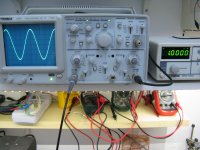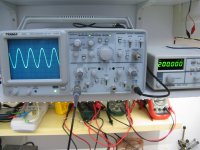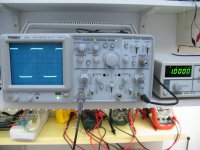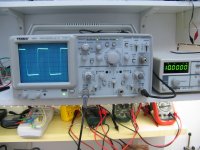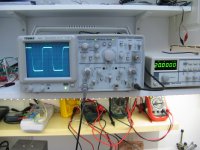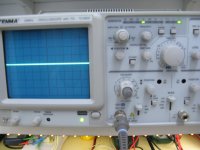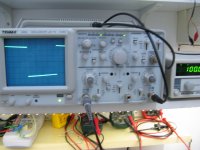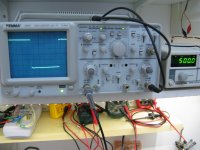And some with the pot half way.
Last is on the output of SSHV2 on the anode choke, full BW and gain with 10X probes on my 20 MHz scope.
Last is on the output of SSHV2 on the anode choke, full BW and gain with 10X probes on my 20 MHz scope.
Attachments
Grid stopper is good to be minimal as long as you don't see more wiggles than with a reasonably higher value. Bandwidth looks 0.25MHZ -3dB indeed when comparing 1st and last pic. Not bad for 20dB gain high capacitance power tube used for line duty. 20kHZ square looks OK too. 1kHZ square is a bit wavy, not edge ringing. Some termination thing maybe, or the signal picking something? Changing x1, x10 on probe, or changing the crock ground point, changes something there? Or when using the 1K original grid stopper?
P.S. You posted the second set meantime. Losing only 50kHz at half pot position is not bad at all. The SSHV2 on your choke load looks absolutely behaving and not noisy (10x probe at full scope BW and max vertical sens is challenging). Well done.
P.S. You posted the second set meantime. Losing only 50kHz at half pot position is not bad at all. The SSHV2 on your choke load looks absolutely behaving and not noisy (10x probe at full scope BW and max vertical sens is challenging). Well done.
Grid stopper is good to be minimal as long as you don't see more wiggles than with a reasonably higher value. Bandwidth looks 0.25MHZ -3dB indeed when comparing 1st and last pic. Not bad for 20dB gain high capacitance power tube used for line duty. 20kHZ square looks OK too. 1kHZ square is a bit wavy, not edge ringing. Some termination thing maybe, or the signal picking something? Changing x1, x10 on probe, or changing the crock ground point, changes something there? Or when using the 1K original grid stopper?
P.S. You posted the second set meantime. Losing only 50kHz at half pot position is not bad at all. The SSHV2 on your choke load looks absolutely behaving and not noisy (10x probe at full scope BW and max vertical sens is challenging). Well done.
I always had this wiggle on the 1kHz and puzzled me a bit. Should I increase the grid stopper or it's not important?
Difficult to tell before comparisons with another stopper or by setting the probe and its GND differently. Could be something riding, not typically a ringing profile, and vanishes in the 5kHz pic even, it should have been even more pronounced up to 20kHz sqr wave. DC couple to scope, probe ONLY after the output cap, go x1 100Hz, crock to closest ground point, or even better use the short to GND coil that comes with probes to output RCA from inside. Lets see if it is 50Hz or 100Hz riding.
Check frequency response. 20Hz to 20kHz by octaves. Just give it a sine wave high enough standing on certain lines. Then start with the gen. See if there are some variations in amplitude. It could be the choke in LF. This thing looks too slow to be ringing per se. Also see if the wavy thing changes with amplitude variation from too low to too high.
Flat response is very good news. See with higher grid stopper for the wiggle and the short probe ground thing then. Does a cathode cap change something? Or the DC bias is too close to what the choke can do? Maybe a few mA less changes something? Dropping B+ a bit would change bias for a test.
Don't know the origin for sure we are just investigating. Its interesting to test the grid stopper thing also. If nothing changes again let us know if this curiosity ever resolves by chance with your measuring method, some future change, whatever.
This is ringing
 What you got reminds nothing typical since it comes without an edge excitation. Maybe someone else has seen it before?
What you got reminds nothing typical since it comes without an edge excitation. Maybe someone else has seen it before?
This is ringing

Anode choke is the usual suspect. A Y with small (10-100 maybe pF) over choke with the common connection to ground is what Morgan Jones recommend (cant find the chapter now). What is the current? Chokes are gaped for 25 if I remember correct? Good with some margin there.
- Home
- Amplifiers
- Tubes / Valves
- 6V6 line preamp
